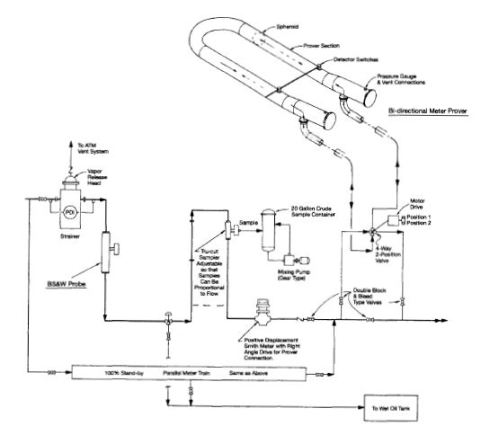In large facilities oil is typically sold through a LACT unit, which is designed to meet API Standards and whatever additional measuring and sampling standards are required by the crude purchaser. The value received for the crude will typically depend on its gravity, BS+W ( Basic Sediment+Water) content, and volume. Therefore, the LACT unit must not only measure the volume accurately, but must continuously monitor the BS+W content and take a sufficiently representative sample so that the gravity and BS+W can be measured.

Figure: Typical LACT Unit Schematic
Above figure shows schematically the elements of a typical LACT unit. The crude first flows through a strainer/gas eliminator to protect the meter and to assure that there is no gas in the liquid. An automatic BS+W probe is mounted in a vertical run. When BS+W exceeds the sales contract quality this probe automatically actuates the diverter valve, which blocks the liquid from going further in the LACT unit and sends it back to the process for further treating. Some sales contracts allow for the BS+W probe to merely sound a warning so that the operators can manually take corrective action. The BS+W probe must be mounted in a vertical run if it is to get a true reading of the average quality of the stream. Downstream of the diverter a sampler in a vertical run takes a calibrated sample that is proportional to the flow and delivers it to a sample container.
The sampler receives a signal from the meter to assure that the sample size is always proportional to flow even if the flow varies. The sample container has a mixing pump so that the liquid in the container can be mixed and made homogeneous prior to taking a sample of this fluid. It is this small sample that will be used to convert the meter reading for BS+W and gravity. The liquid then flows through a positive displacement meter. Most sales contracts require the meter to be proven at least once a month and a new meter factor calculated. On large installations a meter prover such as that shown in Figure above is included as a permanent part of the LACT skid or is brought to the location when a meter must be proven. The meter prover contains a known volume between two detector switches. This known volume has been measured in the factory to ±0.02% when measured against a tank that has been calibrated by the National Bureau of Standards. A spheroid pig moves back and forth between the detectors as the four-way valve is automatically switched. The volume recorded by the meter during the time the pig moves between detectors for a set number of traverses of the prover is recorded electrically and compared to the known volume of the meter prover. On smaller installations, a master meter that has been calibrated using a prover may be brought to the location to run in series with the meter to be proven. In many onshore locations a truck-mounted meter prover is used. The sales meter must have a proven repeatability of ±0.02% when calibrated against a master meter or ±0.05% when calibrated against a tank or meter proven.
Reference: Design of oil handling systems & facilities, Surface Production Operations Volume-1
